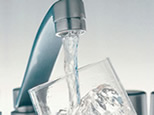
07 Jul Tap Water
DID YOU KNOW
Boiling water does little more than kill bacteria that can’t survive at 100 degrees Celsius and evaporates chlorine gas. It does very little to improve water quality.
Water pollutants
- Chlorine – There are a number of health concerns associated with the use of chlorine in the water supply. Firstly it acidifies the water (lowers pH) thereby increasing the leaching of heavy metals such as copper and lead. It kills bacteria in your gut which plays an important role in the health of your digestive and immune system. Lastly, it combines with organic matter (such as leaf litter in the rivers) to creates cancer causing trihalomethanes. This is why most European countries DO NOT chlorinate their water supply.
- Fluoride – 97% of countries around the world DO NOT fluoridate their water supply for two reasons: it is unethical to mass medicate an entire population with a drug that cannot be monitored by a doctor and secondly, it causes health problems such as dental fluorosis, an increased risk of osteoporosis and hip fractures (fluoride displaces calcium in the bone and makes it more brittle) and osteosarcoma (bone cancer). Its ability to reduce tooth decay is unfounded given that there were similar declines in tooth decay in every western country most of whom did not fluoridate their water supplies. A list of tooth decay trends in fluoridated versus unfluoridated countries is available at www.fluoridealert.org.
- Aluminium – there are unexplained links between human exposure to aluminium and the incidence, progression and aetiology of Alzheimer’s disease (Exley et al, 2006) especially in light of the fact that elevated concentrations of aluminium have been found in the autopsied brains of people who suffered from this disease (Perl and Brody, 1980). If your hot water is derived from a hot water tank, an aluminium anode rod will most likely be used to prolong the life of the tank. Aluminium ions may be present in your hot water which is why you should never DRINK or COOK with hot water from the tap. These levels are not regulated by any authority.
- Lead – may arise from lead solder on metal pipe, brass taps, lead pipe (used prior to 1930), and PVC pipe. Lead poses a major risk to children’s physical and mental health with extensive research associating it with a reduced IQ, impaired hearing, anti-social behaviour, learning and behaviourhal disorders such as Attention Deficit Hyperactivity Disorder, as well as increased aggressive behaviour and criminal tendencies to name only a few! (The Lead Group, 2010). Lead contamination in household drinking water is likely to be grossly underestimated in Australia. Read more…
- Copper – if your water comes out a bluey-green colour for the first few seconds, that’s a sure sign you have copper pipes. Another sign is a green/blue stain around the bath tub ring. Copper in low doses may cause fatigue, irritability, headache, as well as muscle twitches and joint pains and in high levels may cause stomach cramps, nausea, vomiting and diarrhoea, as well as liver and kidney damage (Agency for Toxic Substances and Disease Registry, 2004).
- Pesticides – despite the fact that there are thousands of pesticides currently registered for use in Australia, very few of these are tested in our waterways on a regular basis.
Want to learn more?
- Step 1: Read Chapter 5: Drinking Water in the Healthy Home Healthy Family book
- Step 2: Enrol in the Drinking Water course
- Step 3: Consider a career as a Building Biologist
